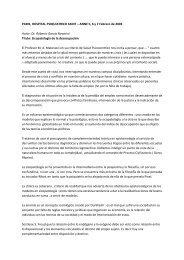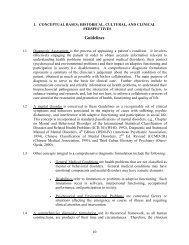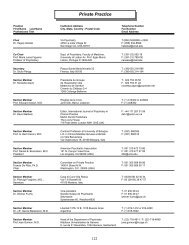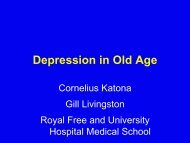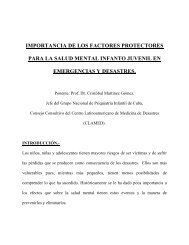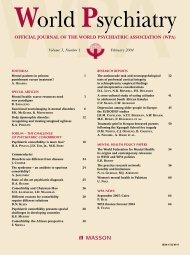ABSTRACTS - World Psychiatric Association
ABSTRACTS - World Psychiatric Association
ABSTRACTS - World Psychiatric Association
You also want an ePaper? Increase the reach of your titles
YUMPU automatically turns print PDFs into web optimized ePapers that Google loves.
elease in hippocampus. We now report that acute stress (footshock)<br />
induces a marked increase of glutamate release in prefrontal/frontal<br />
cortex, while antidepressants completely abolish this stress-induced<br />
increase. We suggest that this is a component of the therapeutic<br />
action of these drugs, particularly the anxiolytic effect. Schizophrenia<br />
is also characterized by marked alterations in glutamate system. Further<br />
support came recently from genetic studies showing a link<br />
between this system and several susceptibility genes. Although mainly<br />
affecting D2 and other monoamine receptors, it has been shown<br />
that antipsychotic drugs may regulate the expression and synaptic<br />
localization of NMDA/AMPAR. Glutamate compounds are currently<br />
in development, including allosteric modulators of NMDAR (glycine<br />
site), inhibitors of glycine reuptake, positive modulators of AMPAR<br />
(AMPAkines) and agonists of type II metabotropic receptors. A<br />
recent phase 2 clinical study showed that LY2140023, an mGluR2/3<br />
agonist, displays short-term antipsychotic properties similar to olanzapine,<br />
suggesting that glutamate drugs could represent a viable alternative<br />
for treatment of schizophrenia.<br />
US22.3.<br />
GABAERGIC GENE PROMOTER<br />
HYPERMETHYLATION DOMINATES PSYCHOSIS<br />
PATHOPHYSIOLOGY AND COULD BE A TARGET<br />
FOR TREATMENT<br />
A. Guidotti, E. Dong, D.R. Grayson, E. Costa<br />
Department of Psychiatry, University of Illinois at Chicago,<br />
IL, USA<br />
Post-mortem brain studies of schizophrenia (SZ) and bipolar (BP)<br />
disorder show a downregulation of GAD67 and reelin expression in<br />
specific populations of GABAergic neurons, very probably associated<br />
with promoter hypermethylation mediated by an overexpression of<br />
DNA methyltrasferase-1 (DNMT1). This is supported by clinical<br />
studies with methionine. Administered for 2-3 weeks in doses of 10-<br />
20g/day, this amino acid increases the brain levels of the methyl<br />
donor S-adenosyl-methionine and exacerbates psychotic symptoms<br />
in 40-50% of SZ patients. In addition to an increase of DNMT1, the<br />
hypermethylation of reelin and GAD67 promoters may be related to<br />
a decrease of a putative DNA-methyl-CpG demethylase (DNAdemethylase).<br />
The nature and kinetics of this process remain a pressing<br />
concern in the study of psychosis. However, it is now clear that, in<br />
the brain, DNA-demethylase activity can be induced by valproate. In<br />
order to understand the molecular nature of the benefits elicited by a<br />
combination of valproate and antipsychotics in the treatment of SZ<br />
and BP disorder, we studied whether this beneficial action is dependent<br />
upon the induction of a DNA-demethylase activity that targets<br />
GAD67 and reelin promoters. In mice receiving clinically relevant<br />
doses of clozapine, both GAD67 and reelin promoters are demethylated<br />
in a manner that is facilitated by valproate. In contrast, even in<br />
the presence of valproate, haloperidol does not share these properties.<br />
This probably explains the greater antipsychotic efficacy of clozapine<br />
compared to haloperidol in association with valproate. The data<br />
suggest that drugs which downregulate promoter hypermethylation in<br />
GABAergic neurons may offer a new approach to treatment for SZ<br />
and related psychiatric disorders.<br />
US23.<br />
INTERMEDIATE PHENOTYPES IN PSYCHIATRY<br />
US23.1.<br />
INTERMEDIATE PHENOTYPES IN SCHIZOPHRENIA<br />
GENETICS<br />
D.R. Weinberger<br />
Genes, Cognition and Psychosis Program, Intramural Research<br />
Program, National Institute of Mental Health, Bethesda,<br />
MD, USA<br />
It is a given that genes related to psychopathology are not about psychiatric<br />
diagnoses per se, but are likely related to the development<br />
and function of brain circuits involved in the processing of cognitive<br />
and emotional information. This has encouraged interest in characterizing<br />
so-called intermediate phenotypes or endophenotypes related<br />
to genetic risk for schizophrenia, which are expected to show<br />
greater penetrance of genetic risk factors. A similar approach has<br />
been employed in the investigation of other complex genetic disorders,<br />
such as adult onset diabetes, in which multiple genes each<br />
account for only a very small share of risk but show stronger effects<br />
on related intermediate phenotypes even in normal subjects – e.g.,<br />
body mass index or glucose induced insulin release. Potential biologic<br />
intermediate phenotypes related to genetic risk for schizophrenia<br />
have included abnormalities in hippocampal and prefrontal cortices,<br />
which are consistently reported in patients with schizophrenia and<br />
are also found with increased frequency in their healthy relatives. For<br />
example, schizophrenia patients and their healthy relatives show<br />
impairments in multiple measures of hippocampal function and biology,<br />
and in prefrontal cortical function and biology. Various physiologic<br />
investigations of cortical activity reveal abnormal activation in<br />
hippocampus and prefrontal cortex within schizophrenia patients<br />
and their healthy relatives. Thus, it follows that genes associated with<br />
susceptibility for schizophrenia might show relatively robust effects<br />
on prefrontal and hippocampal function in risk-allele carrying populations,<br />
even in healthy subjects. Examples of the greater effect size of<br />
potential schizophrenia susceptibility genes on variability in the<br />
expression of these biological phenotypes related to schizophrenia<br />
are reviewed, including COMT, NRG1, DISC1, GRM3, DAARP,<br />
KCNH2, and AKT1.<br />
US23.2.<br />
INTERMEDIATE PHENOTYPES<br />
OR ENDOPHENOTYPES IN PSYCHOSIS:<br />
DATA FROM THE MAUDSLEY STUDIES<br />
R.M. Murray<br />
Institute of Psychiatry, London, UK<br />
Data are presented from the Maudsley twin, family and singleton<br />
studies, which show: a) that deficits in IQ in schizophrenia are largely<br />
determined by the same genetic factors which contribute to the<br />
onset of schizophrenia, b) that there is overlap in the white matter diffusion<br />
tension imaging (DTI) phenotypes between schizophrenia and<br />
bipolar disorder, but that the former, but not the latter, illness is associated<br />
with developmental abnormalities and extensive grey matter<br />
deficits, and c) that certain psychosis susceptibility genes are associated<br />
with differences in brain activation during cognitive challenges.<br />
In particular, variations in COMT, DISC 1, dysbindin and neuregulin<br />
influence cortical function.<br />
25




